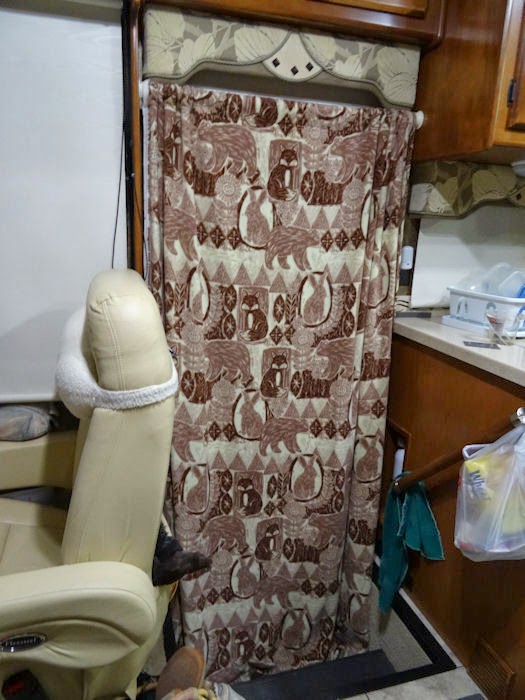When Roger and I decided to go
full-time in our RV we figured that we would need to work for about 3
months a year. That way we won’t have to spend any of our 401K or
other retirement money until we are eligible for social security. 2
years ago I looked into locum tenens organizations who hire doctors
and nurses for temporary work around the country. Since there is a
doctor shortage we felt we would have a good chance to get hired. As
we looked into things further it appeared we would have the best chance of both
of us working at the same place during the same time period if we
worked with the Indian Health Service. The first 2 organizations we
worked with weren’t much help but the third we contacted found 2
concurrent spots in Chinle, AZ, which is in the middle of the Navajo
reservation.
 |
| Reflectix over the kitchen window |
Thank goodness for the internet because
we were able to immediately look it up and discovered that in winter the
temperatures go down to 17 degrees. This worried us because the plan
for most full-time RVers is to follow the 70 degree weather south in the winter.
Unfortunately, there aren’t that many large indian reservations below
Interstate 10, which is where the 70 degree weather is in the U.S. winter. A
large reservation is generally the only place where 2 physicians are likely to be needed at once,
so there weren’t a lot of options. We inquired through the
Escapees RV forums about how to survive in cold weather when living in
an RV. We got lots of good answers which we tried to follow once we got our
acceptance to go to Chinle in mid-February.
 |
| Vent pillow |
So in December we started preparing.
We bought a Vortex electric heater in case our propane heater didn’t
work. We bought 2 small 250 watt personal heaters, one of which we use in the
bathroom, the other we haven't really needed. Cooking and breathing release a lot of moisture into the tiny air space inside a motor home, which can then condense out on cold walls and windows, causing mildew problems. So we bought a dehumidifier, which we haven’t used because it turns out
the humidity in Chinle hovers right around 15-20% and we don't breath that much.
We bought Refectix at Home
Depot
and cut it to fit all of our windows.  |
| Skylight cover |
We taped and blow dried shrink wrap over the window in the door so we can still see out but it is better
insulated. It's like making a double pane window on the really cheap. We put foam weather stripping around the door to seal
 |
| Our fleece door drape |
some large leaks
the manufacturer had left around the frame. I also sewed a fleece drape that we hang each night
on a closet rod Roger installed over the door which reduces any residual drafts.
We learned that in order to prevent the fresh water tank in the rig (and
tanks full of other unmentionable fluids) from freezing we need to use propane rather than electric heat
at night because our propane furnace has vents going into the basement storage areas.
We also learned that we would need to disconnect
and empty out the water hose when the temperature goes below freezing at night so the water inside doesn't freeze and split open the line.
We had Wippert’s RV Service seal any holes they could find on the underside of the rig. They also
attached an Extend-a-Stay T-valve to our propane line so we could hook up a large external propane tank and not have to worry about running out of propane at
inconvenient times. One hundred gallons of propane goes a long way.
 |
| Our rented external propane tank |
So how have we done in the cold?
Actually quite well. We have stayed warm and cozy and nothing has frozen. Being in a motor home at 15 or 16 degrees was scary at first but it turns out this rig tolerates the cold quite well. And the sub-freezing temps here usually only last two or three hours. Once the sun comes up it warms right up. The first 6 weeks it went below freezing almost every night but was rarely still there by 9:00 AM.
Of course, none of this really prepared us for the windstorms, but that is for another blog
post.
 |
| It warms right up once the sun comes out |